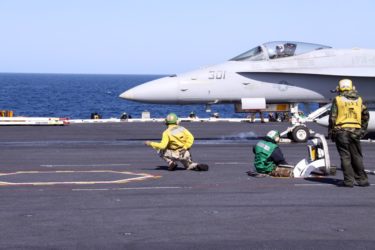 Part 2 – After 30+ Years, I’m Back on the Flight Deck
Part 2 – After 30+ Years, I’m Back on the Flight Deck
This is the second post of a three-part series about writing your memoir.
Last week, I blogged about why you may want to write your own memoir. I also provided some simple tips, outlines, and writing prompts to help you get started.
While I’m a Navy veteran, my dad was Army (80th Infantry Division) as well as my father-in-law (82nd Airborne Division); both fought in World War II. We had many interesting conversations before they passed away. I wrote a book and an oral history about them. That helped me better understand how they dealt with their own war memories.
I know that my own children and their children will now know more about their fathers and grandfathers because of these priceless memoirs.
I encourage you to do the same–write your own memoir. If not for you, then for your children and their children.
You don’t have to be a veteran to write or capture a memoir. What about your parents or grandparents? Even though they may not have served in the military, they’ve still experienced life—in some cases, a long life—and they’ve got a lot to share… in their own words.
Several years ago, my wife conducted an oral history of her mother and learned a few things she didn’t know growing up.
My gracious mother-in-law will be 99 years old next month, and while her body is not as strong as in past years, her mind is still sharp. When she and her younger, 90-year-old sister get together, it is a blast to watch and listen to them reminisce about growing up during the depression in Boston. It’s important to capture those moments and that history; you may not get another chance.
Stay with me here. Back to my memoir…
All I Had to Do Was Ask
Soon after I started working on my memoir, I had a brilliant idea. Since I was in the Navy in the mid-‘70s, I thought it would be interesting to observe and compare today’s recruits and sailors, both during boot camp as well as onboard a ship.
All I had to do was ask.
At the time, there was a Navy Public Affairs office located in Manhattan. I happened to be speaking at a legal technology conference in New York, so I made an appointment to meet with one of the Public Affairs officers. I had previously written a letter to them. But, what the hell, a face-to-face meeting certainly couldn’t hurt.
I asked for three things:
To spend time in boot camp to observe new recruit training, inspections, and graduation.
To spend time aboard an active aircraft carrier (preferably out of San Diego) to observe flight ops.
To land on a carrier and to launch from the carrier.
Guess what? The Navy granted all three wishes. There truly is a Navy genie. But I digress.
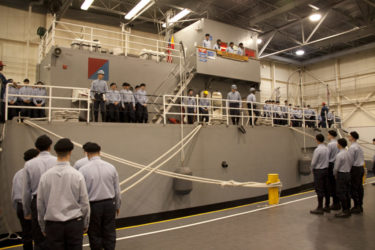 Boot Camp, Then and Now
Boot Camp, Then and Now
I spent three days at Great Lakes RTC and was able to not only observe, but also interview both Recruit Company Commanders and a few recruits. I wanted to compare and contrast today’s recruit training to what I went through in the early ‘70s.
I was able to observe new recruits arriving off the bus (at midnight), receiving their sea bags and uniforms, to observe inspections and training exercises, and, best of all, to attend graduation. I’m a sucker for military traditions, and watching these young new recruits graduate was a great experience.
A few things were obviously different. I went through Orlando RTC in ’73. At that time, there were three Recruit Training Commands: Great Lakes, Orlando, and San Diego. Now there is only one: Great Lakes RTC.
My research took me to Great Lakes, Illinois, in 2009. In the ‘70s, we had one Company Commander for 80 recruits. When I interviewed CCs at Great Lakes in 2009, there were three Company Commanders assigned to a company of 80 recruits.
Remember the “deck parties” during boot camp? You know, pushups, sit-ups, and those hellacious “Hello Dollies,” which seemed to last for hours. Aching muscles and sore backs–built character, didn’t it?
Well, today’s CCs have an “exercise card” they carry with them, indicating the limit of daily recruit exercise time. I don’t know exactly what those limits are, nor do I really care. But the fact that there are now limits to the amount of PT per person per day is…. Well, I simply won’t go there.
Also, while we had female Navy recruits at Orlando RTC, they were berthed and trained in a different part of the Center. The only time we’d see them was during church services, which made for some interesting sermons.
Now male and female recruits train together. IMO, that’s a good thing, especially because they now serve together onboard ships.
The PAO was gracious and accommodating, and I was very appreciative of the time she provided to me, as well as being able to observe almost all activities, especially the graduation ceremonies. I love military traditions and was not disappointed.
Flight Deck Heaven
For those of you who served in the Navy, how many have yearned to go back aboard a ship… at sea… one more time? I know there are many, especially us older veterans. The younger ones? Well, maybe not so much. But you eventually will. I can almost guarantee it.
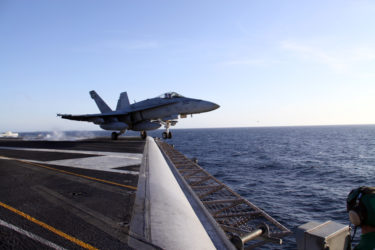 When I was discharged in July ’77, all I wanted to do was to put as much distance between me and Kitty Hawk as I could. I was “done” with her, and I was “done” with the Navy. But, for the past 25+ years (before writing my memoir), all I wanted to do was to spend one more day with her.
When I was discharged in July ’77, all I wanted to do was to put as much distance between me and Kitty Hawk as I could. I was “done” with her, and I was “done” with the Navy. But, for the past 25+ years (before writing my memoir), all I wanted to do was to spend one more day with her.
Anyone else feel that way?
In March 2009, the Navy flew me out on a C-2 Greyhound COD (Carrier On-board Delivery), along with seven other VIPs (why they called us VIPs is beyond me), from NAS North Island (San Diego) to USS Ronald Reagan, CV-76. I spent two days aboard.
Let me tell you about it.
First of all, I figured they would let me observe flight deck operations from the Vulture’s Row, near the bridge. Nope. My “guide” was a fellow ABH who was the Flight Deck Officer. He gave me a float coat and a cranial helmet and said, “Follow me!”
I was in AB “Hog Heaven.”
After 30+ years, I was out on the flight deck again, right next to launching aircraft and right next to the foul line, watching recovering aircraft, just like the old days. The sights, the sounds, and the smells took me back in time. The cool, clear breeze coming over the bow… just as I remembered.
And yes, I did walk up to the bow, lean over the safety nets, open up my jacket, and “fly.” Just like the old days. What a feeling!
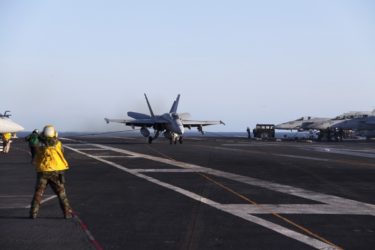
Best of all? I had my camera. There were several areas I was told not to photograph, but none of those were of interest to me. I was focused (pun intended) on flight operations.
The major difference I noticed was that most of the aircraft were various models of the F-18 Hornets. I guess that makes sense for maintenance, parts, mechanic training, pilot training, etc.
But I missed the variety of aircraft from my day: A-7 Corsairs, F-4 Phantoms, F-14 Tomcats, A-6 Intruders, EA-6 Prowlers, S-3 Vikings, A-3 Skywarriors, and A-5 Vigilantes. They were all great aircraft and served a purpose at one time. My favorite back then? The A-7 Corsair.
Since I had been in V-1 Division/Crash & Salvage, another major difference I noticed was the Crash equipment. No longer MB-5s (I wrote about them earlier). Now, the Crash Crew rides a smaller unit, the P-25 Mobile Firefighting Unit. It’s smaller and more maneuverable. But, it’s still Crash and they still the have same motto, “You Light ‘em, We Fight ‘em.”
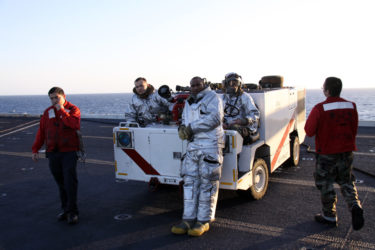 One more observation. Back in the mid-‘70s, there were 27 active aircraft carriers in service around the world; we had 14 crew members in Crash. We had to have 11 Crash crew on deck at all times during flight ops. That made for some long hours and, at times, double shifts.
One more observation. Back in the mid-‘70s, there were 27 active aircraft carriers in service around the world; we had 14 crew members in Crash. We had to have 11 Crash crew on deck at all times during flight ops. That made for some long hours and, at times, double shifts.
In 2009, aboard USS Ronald Reagan, I counted 26 crew members in Crash. I also note that the US Navy now only has 11 active aircraft carriers. So, more sailors are available for billets? I don’t know the numbers, but it seemed more than a coincidence.
Getting There & Back
During my 2½ years aboard USS Kitty Hawk, I witnessed (up-close) literally thousands of launches and recoveries. I always wondered what it would be like to land on a carrier. And better? To experience a catapult launch.
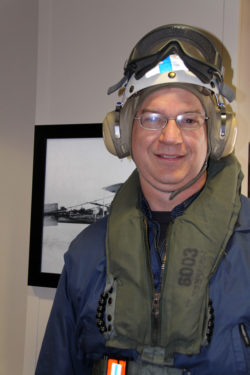
Well, my wish came true. The landing was cool, but the launch… spectacular!
It wasn’t a fighter aircraft or a bomber—it was just the COD. But, to be able to experience a cat launch was something I’ll never forget.
To this day, I can still “feel” that cat launch (in the COD, passengers face aft). But those two seconds of straining toward the rear of the aircraft, holding your breath, sucking in your chest, and not wanting it to end… and then that release… well, those two seconds still stay with me, even today.
One more thing…
I figured since the Navy granted me these three wishes for writing my book (Boot Camp, Active Carrier, Land/Launch), I might look at writing another Navy book – this one about the Blue Angels [<wide grin>].
Writing Prompts
I mentioned in last week’s blog about writing prompts. The idea is that you have a story to tell, whether it’s just a simple, short one-page story about a certain event, a one-chapter story about a tour of duty, or a start-to-finish memoir. Here’s a few more writing prompts for this week:
The Navy (or Army, USMC, USAF, or USCG) gave me the ability to (do what?).
My job in the Navy (or Army, USMC, USAF, USCG) was (what? Provide the details and what you did on a daily basis).
The most influential veteran I served with in my military service was (who?).
Since I’ve covered the basics of writing and researching your memoir, next week I’ll cover the final step: Publishing your memoir. In this case, what does it take to self-publish?

Wendy Thornton
Thanks for this – great article!
Andy Adkins
One of the highlights of my writing “career.” Research. It was even deductible… a plus!